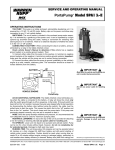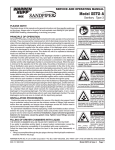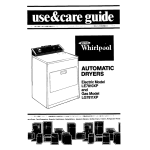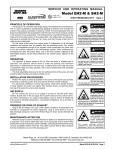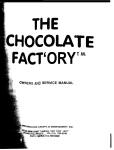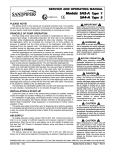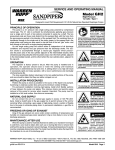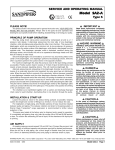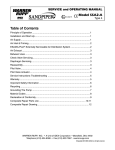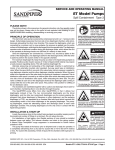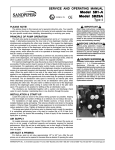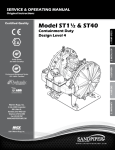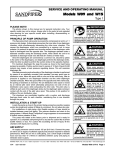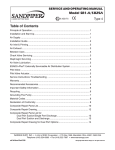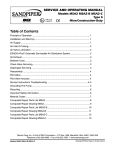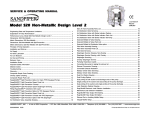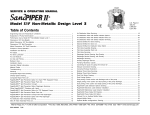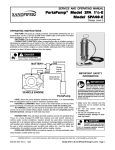Download PDF
Transcript
SERVICE AND OPERATING MANUAL Model PB 1/2 -A Type 3 PLEASE NOTE! The photos in this manual are for general instruction only. Your specific model may not be shown. Always refer to the parts list and exploded view drawing for your specific model when installing, disassembling or servicing your pump. PRINCIPLE OF PUMP OPERATION This ball check valve pump is powered by compressed air and is a 1:1 pressure ratio design. It alternately pressurizes the inner side of one diaphragm chamber, while simultaneously exhausting the other inner chamber. This causes the diaphragms, which are connected by a common rod, to move endwise. Air pressure is applied over the entire surface of the diaphragm, while liquid is discharged from the opposite side. The diaphragm operates under a balanced condition during the discharge stroke, which allows the unit to be operated at discharge heads over 200 feet (61 meters) of water head. Since the diaphragms are connected by a common rod, secured by plates to the center of the diaphragms, one diaphragm performs the discharge stroke, while the other is pulled to perform the suction stroke in the opposite chamber. For maximum diaphragm life, keep the pump as close to the liquid being pumped as possible. Positive suction head in excess of 10 feet of liquid (3.048 meters) may require a back pressure regulating device. This will maximize diaphragm life. Alternate pressuring and exhausting of the diaphragm chamber is performed by means of an externally mounted, pilot operated, four-way spool type air distribution valve. When the spool shifts to one end of the valve body, inlet air pressure is applied to one diaphragm chamber and the other diaphragm chamber exhausts. When the spool shifts to the opposite end of the valve body, the porting of chambers is reversed. The air distribution valve spool is moved by an internal pilot valve which alternately pressurizes one side of the air distribution valve spool, while exhausting the other side. The pilot valve is shifted at each end of the diaphragm stroke by the diaphragm plate coming in contact with the end of the pilot valve spool. This pushes it into position for shifting of the air distribution valve. The chambers are manifolded together with a suction and discharge check valve for each chamber, maintaining flow in one direction through the pump. IMPORTANT Read these instructions completely, before installation and start-up. It is the responsibility of the purchaser to retain this manual for reference. Failure to comply with the recommendations stated in this manual will damage the pump, and void factory warranty. WARNING Take action to prevent static sparking. Fire or explosion can result, especially when handling flammable liquids. The pump, piping, valves, containers or other miscellaneous equipment must be grounded. CAUTION Operating temperature limitations are as follows: PFA ....... 212°F(100°C) Max to 0°F(-18°C)Min. PVDF .... 200°F(93°C) Max to 10°F(-13°C)Min. Nylon .... 120°F(48°C) Max to 32°F (0°C) Min. Polypro 150°F(65°C) Max to 40°F (5°C) Min. BEFORE OPERATION Before pump operation, inspect all gasketed fasteners for looseness caused by gasket creep. Retorque loose fasteners to prevent leakage prior to start-up. Follow recommended torques stated in this manual. INSTALLATION & START-UP Locate the pump as close to the product being pumped as possible, keeping suction line length and number of fittings to a minimum. Do not reduce line size. For installations of rigid piping, short flexible sections of hose should be installed between pump and piping. This reduces vibration and strain to the piping system. A Warren Rupp Tranquilizer® surge suppressor is recommended to further reduce pulsation in flow. This pump was tested at the factory prior to shipment and is ready for operation. It is completely self-priming from a dry start for suction lifts of 10 feet (3.05 meters) or less. For suction lifts exceeding 10 feet of liquid, fill the chambers with liquid prior to priming. Figure 1: Air Inlet Capscrews AIR VALVE LUBRICATION The SandPlPER pump’s pilot valve and main air valve assemblies are designed to operate WITHOUT lubrication. This is the preferred mode of operation. There may be instances of personal preference, or poor quality air supplies when lubrication of the compressed air supply is required. The pump air system will operate with properly lubricated compressed air supplies. Proper lubrication of the compressed air supply would entail the use of an air line lubricator (available from Warren Rupp) set to deliver one drop of 10 weight, non-detergent oil for every 20 SCFM of air the pump consumed at its point of operation. Consult the pump’s published Performance Curve to determine this. WARREN RUPP, INC. A Unit of IDEX Corporation • P.O. Box 1568 • Mansfield, Ohio 44901-1568 USA • (419) 524-8388 Fax (419) 522-7867 520-041-000 2/99 Model PB½ -A Type 3 Page 1 It is important to remember to inspect the sleeve and spool set routinely. It should move back and forth freely. This is most important when the air supply is lubricated. If a lubricator is used, oil accumulation will, over time, collect any debris from the compressed air. This can prevent the pump from operating properly. Water in the compressed air supply can create problems such as icing or freezing of the exhaust air causing the pump to cycle erratically, or stop operating. This can be addressed by using a point of use air dryer (available from Warren Rupp) to supplement a plant’s air drying equipment. This device will remove excess water from the compressed air supply and alleviate the icing or freezing problem.AIR SUPPLY Air supply pressures cannot exceed 100 psi (6.89 bar). Connect the pump air inlet to an air supply of sufficient capacity and pressure required for desired performance. When the air line is solid piping, use a short length of flexible hose (not less than 3¦4" (19mm) in diameter) between pump and piping to eliminate strain to pipes. AIR INLET & PRIMING For start-up, open an air valve approximately 1¦2 to 3¦4 turn. After the unit primes, an air valve can be opened to increase flow as desired. If opening the valve increases cycling rate, but does not increase flow rate, cavitation has occurred, and the valve should be closed slightly. For the most efficient use of compressed air and the longest diaphragm life, throttle the air inlet to the lowest cycling rate that does not reduce flow. WARNING The weight of the air supply line and of the filter must be supported by some means other than the air valve cap. Failure to provide support may result in damage to the pump. A pressure regulating valve should be installed to prevent pressure from exceeding recommended limits. CAUTION In the event of diaphragm rupture, pumped material may enter the air end of the pump, and be discharged into the atmosphere. If pumping a product which is hazardous or toxic, the air exhaust must be piped to an appropriate area for safe disposition. AIR EXHAUST If a diaphragm fails, the pumped liquid or fumes can enter the air end of the pump, and be exhausted into the atmosphere. When pumping hazardous or toxic materials, pipe the exhaust to an appropriate area for safe disposition. This pump can be submerged if materials of construction are compatible with the liquid. The air exhaust must be piped above the liquid level. Piping used for the air exhaust must not be smaller than 3/8" (.9525 cm). Reducing the pipe size will restrict air flow and reduce pump performance. When the product source is at a higher level than the pump (flooded suction), pipe the exhaust higher than the product source to prevent siphoning spills. Use exhaust kit 475-107-000 to pipe out exhaust. Freezing or icing of the air exhaust can occur under certain temperature and humidity conditions. Use of a Warren Rupp Air Dryer unit should eliminate most icing problems. Figure 2: Exhaust cap assembly. (475-107-000) BETWEEN USES When used for materials that tend to settle out or transform to solid form, the pump should be completely flushed after each use, to prevent damage. Product remaining in the pump between uses could dry out or settle out. This could cause problems with valves and diaphragms at re-start. In freezing temperatures, the pump must be drained between uses in all cases. CHECK VALVE SERVICING Figure 3: Check valve and seat. Need for inspection or service is usually indicated by poor priming, unstable cycling, reduced performance or the pump’s cycling but not pumping. Remove the twelve capscrews securing the manifold assemblies to the outer chambers. Inspect the surfaces of both check valve and seat for wear or damage that could prevent proper sealing. If pump is to prime properly, valves must seat air tight. DIAPHRAGM SERVICING Remove the two V-Band clamps securing the outer chambers to the intermediate housing. Remove the diaphragm assembly (outer plate, diaphragm, inner plate) by turning the assembly counterclockwise using a 3/4" (1.91 cm) wrench on the outer plate lugs. (If a socket is used, it must be a six point socket.) The interior components consisting of the shaft seal and pilot valve assembly are now accessible for service. Procedures for reassembling the diaphragms are the reverse of the above. During reassembly make certain that the rubber bumper is on the rod on each side. Install the diaphragm with the natural bulge outward. Install the outer diaphragm plate on the outside of the diaphragm and make certain that the large radius side of the inner plate is toward the diaphragm. Tighten the outer diaphragm plate to approximately 90 in. lbs. (10.16 Newton meters). Torque while allowing the diaphragm to turn freely with plates. Use a wrench on the outer diaphragm plate of the opposite side to keep rod from rotating. If the opposite chamber is assembled, the rod need not be held. Model PB½ -A Type 3 Page 2 Figure 4: Diaphragm and diaphragm plate. 520-041-000 2/99 A NOTE ABOUT AIR VALVE LUBRICATION CAUTION The SandPiper pump’s pilot valve and main air valve assemblies are designed to operate WITHOUT lubrication. This is the preferred mode of operation. There may be instances of personal preference, or poor quality air supplies when lubrication of the compressed air supply is required. The pump air system will operate with properly lubricated compressed air supplies. Proper lubrication of the compressed air supply would entail the use of an air line lubricator (available from Warren Rupp) set to deliver one drop of 10 wt., non-detergent oil for every 20 SCFM of air the pump consumed at its point of operation. Consult the pump’s published Performance Curve to determine this. It is important to remember to inspect the sleeve and spool set routinely. It should move back and forth freely. This is most important when the air supply is lubricated. If a lubricator is used, oil accumulation will, over time, collect any debris from the compressed air. This can prevent the pump from operating properly. Water in the compressed air supply can create problems such as icing or freezing of the exhaust air causing the pump to cycle erratically, or stop operating. This can be addressed by using a point of use air dryer available from Warren Rupp) to supplement a plant’s air drying equipment. This device will remove excess water from the compressed air supply and alleviate the icing or freezing problem. Before maintenance or repair, shut off the compressed air line, bleed the pressure, and disconnect the air line from the pump. The discharge line may be pressurized and must be bled of its pressure. When used for toxic or aggressive fluids, the pump should always be flushed clean prior to disassembly. ESADS: EXTERNALLY SERVICEABLE AIR DISTRIBUTION SYSTEM Figure 5: Sleeve and spool set. Please refer to the exploded view drawing and parts list in the Service Manual supplied with your pump. If you need replacement or additional copies, contact your local Warren Rupp Distributor. or the Warren Rupp factory Literature Department at the number shown below To receive the correct manual, you must specify the MODEL and TYPE information found on the name plate of the pump. The main air valve sleeve and spool set is located in the valve body mounted on the pump with four hex head capscrews. The valve body assembIy is removed from the pump by removing these four hex head capscrews. With the valve body assembly off the pump, access to the sleeve and spooI set is made by removing a retaining ring (each end) securing the end cap on the valve body assembly. With the end caps removed, slide the spool back and forth in the sleeve. The spool is closely sized to the sleeve and must move freely to allow for proper pump operation. An accumulation of oil, dirt or other contaminants from the pump’s air supply, or from a failed diaphragm, may prevent the spool from moving freely. This can cause the spool to stick in a position that prevents the pump from operating. If this is the case, the sleeve and spool set should be removed from the valve body for cleaning and further inspection. Remove the spool from the sleeve. Using an arbor press or bench vise (with an improvised mandrel), press the sleeve from the valve body. Take care not to damage the sleeve. At his point, inspect the o-rings on the sleeve for nicks, tears or abrasions. Damage of this sort could happen during assembly or servicing. A sheared or cut oring can allow the pump’s compressed air suppiy to leak or bypass within the air valve assembly, causing the pump to leak compressed alr from the pump air exhaust or not cycle properly. This is most noticeable at pump dead head or high discharge pressure conditions. Replace any of these o-rings as required or set up a routine, preventive maintenance schedule to do so on a regular basls. This practice should include cleaning the spool and sleeve components with a safety solvent or equivalent, inspecting for signs of wear or damage, and replacing worn components. To re-install the sleeve and spool set, Iightly lubricate the o-rings on the sleeve with an o-ring assembly lubricant or lightweignt oil (such as 10 wt. air line lubricant). Press the set into the valve body easily, without shearing the o-rings. Re-install one end cap, and retaining ring on the valve body. Using the arbor press or bench vise that was used in disassembly, press the sleeve back into the valve body. Re-install the spool, keeping the counter-bored end toward you, and install the spring, opposite end cap and retaining ring on the valve body. After inspecting and cleaning the gasket surfaces on the valve body and intermediate, re-install the valve body on the pump using new gaskets. Tighten the four hex head capscrews evenly and in an alternating cross pattern, at 70 in./lbs. (7.9 Newton meters). 520-041-000 2/99 Figure 6: Disassembling the pilot valve. Figure 7: Pilot valve with o-rings. Model PB½ -A Type 3 Page 3 PILOT VALVE ACTUATOR The pilot valve spool (item 9C) contains 6 o-rings (item 9D). This spool moves through the sleeve (item 9B). Check condition of o-rings for cuts or gouges before reassembly. Apply a light coating of grease to the o-rings when inserting into the sleeve. Insert spool into sleeve from chamfered side. The o-ring on the end should be installed after the spool is in place (install last). Make sure the sleeve is locked into the intermediate bracket (item 16) with retainer ring ( item 9E). Fig. 7. TROUBLESHOOTING 1. Pump wlll not cycle A. Check to make sure the unit has enough pressure to operate and that the air inlet valve is open. B. Check the discharge line to insure that the discharge line is neither closed nor blocked. C. If the spool in the air distribution valve is not shifting, check the main spool. It must slide freely. D. Excessive air leakage in the pump can prevent cycling. This condition will be evident. Air leakage into the discharge line indicates a ruptured diaphragm. Air leakage from the exhaust port indicates leakage in the air distribution valve. See further service instructions. E. Blockage in the liquid chamber can impede movement of diaphragm. 2. Pump cycles but wlll not pump A. Suction side of pump pulling in air. Check the suction line for air leaks and be sure that the end of the suction line is submerged. Check flange bolting. Check valve flanges and manifold to chamber flange joints. B. Make certain the suction line or strainer is not plugged. Restriction at the suction is indicated by a high vacuum reading when a vacuum gauge is installed in the suction line. C. Check valves may not be seating properly. To check, remove the suction line and cover the suction port with your hand. If the unit does not pull a good suction (vacuum), the check valves should be inspected for proper seating. D. Static suction lift may be too high. Priming can be improved by elevating the suction and discharge lines higher than the check valves and pouring liquid into the unit through the suction inlet. When priming at high suction lifts or with long suction lines operate the pump at maximum cycle rate. 3. Low performance A. Capacity is reduced as the discharge pressure increases, as indicated on the performance curve. Performance capability varies with available inlet air supply. Check air pressure at the pump inlet when the pump is operating to make certain that adequate air supply is maintained. B. Check vacuum at the pump suction. Capacity is reduced as vacuum increases. Reduced flow rate due to starved suction will be evident when cycle rate can be varied without change in capacity. This condition will be more prevalent when pumping viscous liquids. Viscosity is limited to a maximum of 10,000 SSU. When pumping thick, heavy materials the suction line must be kept as large in diameter and as short as possible, to keep suction loss minimal. C. Low flow rate and slow cycling rate indicate restricted flow through the discharge line. Low flow rate and fast cycling rate indicate restriction in the suction line or air leakage into suction. D. Unstable cycling indicates improper check valve seating on one chamber. This condition is confirmed when unstable cycling repeats consistently on alternate exhausts. Cycling that is not consistently unstable may indicate partial exhaust restriction due to freezing and thawing of exhaust air. Use of an anti-freeze lubricant in an air line lubricator should solve this problem. For additional information, see the Warren Rupp Troubleshooting Guide. RECOMMENDED WARREN RUPP ACCESSORIES TO MAXIMIZE PUMP PERFORMANCE: • Tranquilizer® Surge Suppressor. For nearly pulse-free flow. • Warren Rupp Air Dryer. For clean, dry compressed air. • WarrenRupp Filter/Regulator. For modular installation and service convenience. • Warren Rupp Speed Control. For manual or programmable process control. Manual adjustment or 4-20mA reception. For more detailed information on these accessories, contact your local Warren Rupp Factory-Authorized Distributor, or Warren Rupp corporate headquarters. IMPORTANT This pump is pressurized internally with air pressure during operation. Always make certain that all bolting is in good condition and that all of the correct bolting is reinstalled during assembly. WARRANTY This pump is warranted for a period of five years against defective material and workmanship. Failure to comply with the recommendations stated in this manual voids all factory warranty. ©1999 Warren Rupp, Inc. All rights reserved. ®SandPIPER and Tranquilizer are registered tradenames of Warren Rupp, Inc. ®Neverseize is a registered tradename of Loctite Printed in U.S.A. Model PB½ -A Type 3 Page 4 520-041-000 2/99 REPAIR PARTS LIST and DRAWING Model PB 1/2 -A Type 3 ITEM NO. 1 2 3 4 5 6 7 8 9 9A 9B 9C 9D 9E 10 11 12 13 14 15 16 18 19 20 21 22 23 24 25 26 27 28 29 30 PART NUMBER 095-056-551 031-036-000 560-026-360 165-046-356 675-046-115 165-044-551 360-066-360 360-065-360 031-054-000 560-066-360 755-032-162 775-024-115 560-001-360 675-047-115 170-053-115 170-019-115 360-074-360 286-034-604 560-073-611 560-073-360 170-080-115 901-038-115 114-010-551 165-064-551 710-013-115 530-021-550 685-042-120 720-021-359 612-092-150 132-021-360 200-045-115 100-001-115 545-022-337 286-033-354 286-033-356 286-033-360 286-033-363 286-033-364 286-033-365 612-091-552 612-091-520 612-091-542 612-091-606 196-058-552 196-058-520 196-058-542 196-058-606 DESCRIPTION Spool Valve Body Sleeve & Spool Set O-Ring End Cap Retaining Ring Valve Cap Valve Body Gasket Valve Cap Gasket Pilot Valve Assembly O-Ring, Sleeve Sleeve Spool O-Ring, Spool Ring, Retainer Hex Head Capscrew Hex Head Capscrew (Teflon Wetted Pumps Only) Gasket Spacer1 Overlay Diaphragm O-Ring O-Ring Hex Head Capscrew Flat Washer Intermediate Bracket Muffler Cap 3 Self-Tapping Screw 3 Muffler 3 Diaphragm Rod Rod Seal Inner Diaphragm Plate Bumper V-Band Clamp Assembly (Includes Items 26 & 27) Tee Bolt Hex Nut Diaphragm Diaphragm Diaphragm Diaphragm Diaphragm Diaphragm Outer Diaphragm Plate Outer Diaphragm Plate Outer Diaphragm Plate Outer Diaphragm Plate Outer Chamber Outer Chamber Outer Chamber Outer Chamber TOTAL RQD. 1 1 8 2 2 1 1 1 1 6 1 1 6 1 6 6 2 2 4 4 4 4 1 1 6 1 1 2 2 2 2 2 2 2 2 2 2 2 2 2 2 2 2 2 2 2 2 Repair Parts shown in bold face (darker) type are more likely to need replacement after extended periods of normal use. They are readily available from most Warren Rupp distributors. The pump owner may prefer to maintain a limited inventory of these parts in his own stock to reduce repair downtime to a minimum. IMPORTANT: When ordering repair parts always furnish pump model number, serial number and type number. MATERIAL CODES The Last 3 Digits of Part Number 000…Assembly, sub-assembly; and some purchased Items 010…Cast Iron 012…Powered Metal 015…Ductile Iron 020…Ferritic Malleable Iron 025…Music Wire 080…CarbonSteel AISI B-1112 100…Alloy 20 110…Alloy Type 316 Stainless Steel 111…Alloy Type 316 Stainless Steel (Electro Polished) 112…Alloy “C” 113…Alloy Type 316 Stainless Steel (Hand Polished) 114…303 Stainless Steel 115…302/304 Stainless Steel 117…440-C Stainless Steel (Martensitic) 120…416 Stainless Steel (Wrought Martensitic) 123…410 Stainless Steel (Wrought Martensitic) 148…Hardcoat Anodized Aluminum 149…2024-T4 Aluminum 150…6061-T6 Aluminum 151…6063-T6 Aluminum 152…2024-T4 Aluminum (2023-T351) 154…Almag 35 Aluminum 155 or 156…356-T6 Aluminum 157…Die Cast Aluminum Alloy #380 158…Aluminum Alloy SR-319 159…Anodized Aluminum 162…Brass, Yellow, Screw Machine Stock 165…Cast Bronze, 85-5-5-5 166…Bronze SAE 660 170…Bronze, Bearing Type, Oil Impregnated 180…Copper Alloy 310…Kynar Coated 330…Zinc Plated Steel 331…Chrome Plated Steel 332…Electroless Nickel Plated 335…Galvanized Steel 336…Zinc Plated Yellow Brass 337…Silver Plated Steel 340…Nickel Plated 342…Filled Nylon 354…Injection Molded #203-40 Santoprene - Duro 40D ± 5; Color: RED 355…Thermoplastic Elastomer 356…Hytrel 357…Rupplon (Urethane Rubber) Color coded:PURPLE 358…Rupplon (Urethane Rubber) Color coded:PURPLE (Some Applications, Compression Mold) 359…Urethane Rubber 360…Buna-N Rubber Color coded: RED 361…Buna-N 363…Viton (Fluorel) Color coded: YELLOW 364…E.P.D.M. Rubber Color coded: BLUE 365…Neoprene Rubber Color coded: GREEN 370…Butyl Rubber Color coded: BROWN 371…Philthane (Tuftane) List continued next page WARREN RUPP, INC. A Unit of IDEX Corporation • P.O. Box 1568 • Mansfield, Ohio 44901-1568 USA • (419) 524-8388 Fax (419) 522-7867 520-041-000 2/99 Model PB½ -A Type 3 Page 5 ITEM NO. 31 32 33 PART NUMBER DESCRIPTION 560-071-611 560-071-360 722-046-110 722-046-552 722-046-520 722-046-542 722-046-606 722-063-552 050-022-600 050-027-354 050-027-356 050-027-360 O-Ring O-Ring Seat Seat Seat Seat Seat Seat 2 Check Valve Ball Check Valve Ball Check Valve Ball Check Valve Ball (use with seat 722-063-552) Check Valve Ball (use with seat 722-063-552) Discharge Elbow Discharge Elbow Discharge Elbow Discharge Elbow Suction Elbow Suction Elbow Suction Elbow Suction Elbow Manifold Manifold Manifold Manifold Self-Tapping Screw Hex Head Capscrew Hex Head Capscrew (Teflon Wetted Pumps Only) Washer Manifold Dual Port (Optional) 050-027-365 34 35 36 37 38 39 40 312-042-552 312-042-520 312-042-542 312-042-606 312-043-552 312-043-520 312-043-542 312-043-606 518-067-552 518-067-520 518-067-542 518-067-606 710-011-115 170-063-115 170-001-115 901-037-115 518-101-552 Not Shown 535-015-000 710-010-115 031-043-551 547-002-115 TOTAL RQD. 4 4 4 4 4 4 4 4 4 4 4 4 4 2 2 2 2 2 2 2 2 2 2 2 2 8 6 6 12 1/2 Name Plate 1 Self-Tapping Screw 4 Air Valve Body Assembly 1 (Incl. Items 1, 2, 3, 4, 5) Stop Nut (Used to hold suction and 12 discharge elbow to the outer chambers) 1 Standard production on non-overlay models, but also required on overlay models if disassembly has occurred for repair. 2 Repair Parts shown in bold face (darker) type are more likely to need replacement after extended periods of normal use. They are readily available from most Warren Rupp distributors. The pump owner may prefer to maintain a limited inventory of these parts in his own stock to reduce repair downtime to a minimum. IMPORTANT: When ordering repair parts always furnish pump model number, serial number and type number. MATERIAL CODES The Last 3 Digits of Part Number Continued from previous page 375…Fluorinated Nitrile 378…High density Polypropylene 405…Cellulose Fibre 408…Cork and Neoprene 425…Compressed Fibre 426…Blue Gard 440…Vegetable Fibre 465…Fibre 500…Delrin 500 501…Delrin 570 505…Acrylic Resin Plastic 520…Injection Molded PVDF Natural Color 540…Nylon 541…Nylon 542…Nylon 544…Nylon Injection Molded 550…Polyethylene 551…Polypropylene 552…Unfilled Polypropylene 553…Unfilled Polypropylene 555…Polyvinyl Chloride 570…Rulon II 580…Ryton 590…Valox 591…Nylatron G-S 592…Nylatron NSB 600…Teflon (virgin material) Tetrafluoroethylene (TFE) 601…Teflon (Bronze and moly filled) 602…Filled Teflon 603…Blue Gylon 604…Teflon 606…Teflon 610…Teflon Encapsulated Silicon 611…Teflon Encapsulated Viton Delrin, Teflon, Viton and Hytrel are registered tradenames of E.I. DuPont. Gylon is a registered tradename of Garlock. Inc. Nylatron is a registered tradename of Polymer Corp. Rulon II is a registered tradename of Dixion Industries Corporation. Hastelloy-C is a registered tradename of Cabot Corp. Ryton is a registered tradename of Phillips Chemical Company. Valox is a registered tradename of General Electric Company. Rupplon, SandPIPER, PortaPump, Tranquilizer, and SludgeMaster are registered tradenames of Warren Rupp Inc. Use only with 050-027-360 or 050-027-365 ball valves. 3 Available as kit only, order 475-130-000. If muffler needs to be piped to area of safe disposition, order exhaust cap kit 475-107-000. Model PB½ -A Type 3 Page 6 520-041-000 2/99 Note: Install Item #9 into the chamfered end of item #16. ©1999 Warren Rupp, Inc. All rights reserved. ®SandPIPER is a registered tradename of Warren Rupp, Inc. Printed in U.S.A. 520-041-000 2/99 Model PB½ -A Type 3 Page 7







